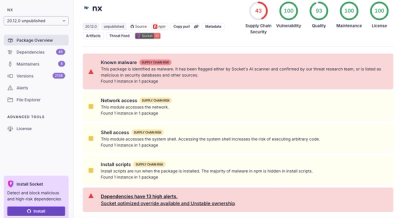
Security News
/Research
Wallet-Draining npm Package Impersonates Nodemailer to Hijack Crypto Transactions
Malicious npm package impersonates Nodemailer and drains wallets by hijacking crypto transactions across multiple blockchains.
@aitodotai/json-stringify-pretty-compact
Advanced tools
The best of both `JSON.stringify(obj)` and `JSON.stringify(obj, null, indent)`.
Fork information: This is a maintained fork which implements these additional options: maxNesting, arrayMargins, and objectMargins.

The output of JSON.stringify comes in two flavors: compact and pretty. The
former is usually too compact to be read by humans, while the latter sometimes
is too spacious. This module trades performance (and the “replacer” argument)
for a compromise between the two. The result is a pretty compact string, where
“pretty” means both “kind of” and “nice”.
{
"bool": true,
"short array": [1, 2, 3],
"long array": [
{"x": 1, "y": 2},
{"x": 2, "y": 1},
{"x": 1, "y": 1},
{"x": 2, "y": 2}
]
}
While the “pretty” mode of JSON.stringify puts every item of arrays and
objects on its own line, this module puts the whole array or object on a single
line, unless the line becomes too long (the default maximum is 80 characters).
Making arrays and objects multi-line is the only attempt made to enforce the
maximum line length; if that doesn’t help then so be it.
npm install @aitodotai/json-stringify-pretty-compact
var stringify = require("json-stringify-pretty-compact")
stringify(obj, [options])It’s like JSON.stringify(obj, null, options.indent), except that objects and
arrays are on one line if they fit (according to options.maxLength).
options:
indent: Defaults to 2. Works exactly like the third parameter of
JSON.stringify.
maxLength: Defaults to 80. Lines will be tried to be kept at maximum this many characters long.
maxNesting: Defaults to Infinity. The maximum amount of allowed inline nesting for objects or arrays
By default, the output can contain arbitrary amount of nested structures (as long as the maxLength is not exceeded), like below:
{"a": [{"b": ["test1", "test2"]}, {"c": true}]}}
When maxNesting is set to 0, the output doesn't allow any nesting:
{
"a": [
{
"b": [
"test1",
"test2"
]
},
{
"c": true
}
]
}
margins: Defaults to false. Whether or not to add “margins” around brackets
and braces:
false: {"a": [1]}true: { "a": [ 1 ] }arrayMargins: Defaults to false. Whether or not to add “margins” around brackets:
false: {"a": [1]}true: {"a": [ 1 ]}arrayMargins: Defaults to true. Whether or not to add “margins” around braces:
false: {"a": [1]}true: { "a": [1] }stringify(obj, {maxLength: 0, indent: indent}) gives the exact same result as
JSON.stringify(obj, null, indent).
stringify(obj, {maxLength: Infinity}) gives the exact same result as
JSON.stringify(obj), except that there are spaces after colons and commas.
Example of publishing new release with patch change:
npm run publish -- patch
MIT.
FAQs
The best of both `JSON.stringify(obj)` and `JSON.stringify(obj, null, indent)`.
The npm package @aitodotai/json-stringify-pretty-compact receives a total of 6,656 weekly downloads. As such, @aitodotai/json-stringify-pretty-compact popularity was classified as popular.
We found that @aitodotai/json-stringify-pretty-compact demonstrated a not healthy version release cadence and project activity because the last version was released a year ago. It has 6 open source maintainers collaborating on the project.
Did you know?

Socket for GitHub automatically highlights issues in each pull request and monitors the health of all your open source dependencies. Discover the contents of your packages and block harmful activity before you install or update your dependencies.

Security News
/Research
Malicious npm package impersonates Nodemailer and drains wallets by hijacking crypto transactions across multiple blockchains.

Security News
This episode explores the hard problem of reachability analysis, from static analysis limits to handling dynamic languages and massive dependency trees.

Security News
/Research
Malicious Nx npm versions stole secrets and wallet info using AI CLI tools; Socket’s AI scanner detected the supply chain attack and flagged the malware.